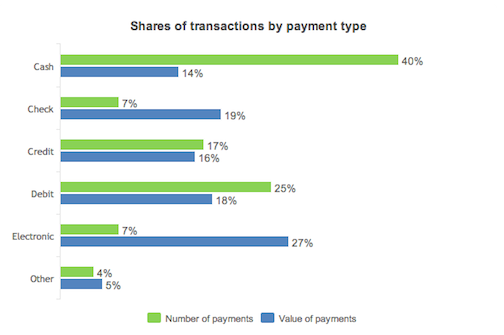Study Confirms That Most Of Us Carry Less Than $50 Cash
Nearly eight in 10 Americans carry less than $50 cash and two out of five carry less than $20 cash on a daily basis, according to a new report by Bankrate.com. Additionally, about 9% of consumers surveyed say they don’t carry cash at all.
“If we move to a truly cashless society, it won’t be much of an adjustment for most Americans,” Greg McBride, Bankrate.com’s chief financial analyst, says.
The report also found that men were more likely than women to carry cash. Nearly 77% of women carry $50 or less daily, while 61% of men carry the same amount.
McBride theorizes that women may carry less cash to reduced the risk of being a target for criminal activity.
Having less cash on hand is just another sign that the traditional tender no longer dominates when it comes to consumer spending. That shouldn’t be much of a surprise considering the plethora of options available to consumers, from debit and credit cards to electronic payment systems on smartphones.
In fact, one expert told Bankrate that while cash won’t be going away anytime soon, the trend toward mobile payments continues to increase.
The electronic payments industry “is doing a good job shifting people away from cash,” George Peabody, a payments strategist at Glenbrook Partners, a payments research firm in Menlo Park, CA, tells Bankrate. “Cash is going to be remarkably resilient. I’m not expecting cash to disappear anytime soon.”
But consumers have many reasons for not carrying cash. Many consumers tell Bankrate that having less cash on hand means they can more easily control their spending. Hannah, a student at the University of Missouri, says she tends to carry less than $20 each day.
“Cash for me is so much easier for me to spend,” she says. “If I have a lot in my wallet, I’m immediately going to spend it. Twenty dollars is enough to go out on the weekend or get lunch between classes, but not enough to go buy something crazy.”
Hannah isn’t alone in her sentiment that having more cash makes you want to spend more. Joydeep Srivastava, a professor of marketing at the University of Maryland, says many consumers consider cash in their wallet as petty cash.
“As soon as you draw it from the ATM, it’s like you’ve already spent it,” he says. “You don’t feel that pang of guilt of spending it anymore.”
Even with recent high-profile data security breaches at retailers nationwide, some experts say consumers feel more secure using plastic than cash. If a consumer loses a $20 bill from their wallet, they’re out $20. But if someone fraudulently charges $20 to your credit card, you often don’t have any liability, Jason Oxman, CEO of the Electronics Transactions Association tells Bankrate.
Carrying $50 or less doesn’t seem to be hurting the overall popularity of cash though. An April report by the Federal Reserve found that cash was still the most frequently used payment method, although the value of those transactions totaled significantly lower than other methods.
Cash accounted for nearly 40% of all transactions in October 2012, but only 14% of the value of total payments for that time.
The tender was the most popular when it came to transactions less than $10.
Financial Security Index: Cash’s cachet [Bankrate.com]
Want more consumer news? Visit our parent organization, Consumer Reports, for the latest on scams, recalls, and other consumer issues.




